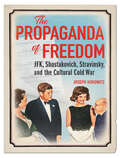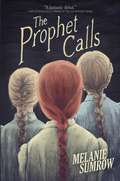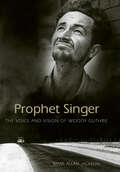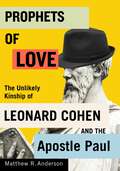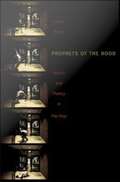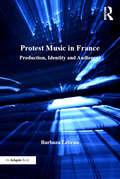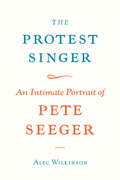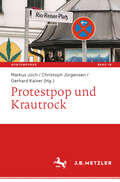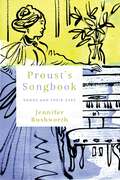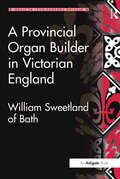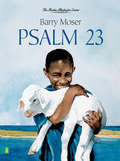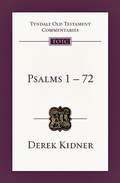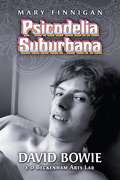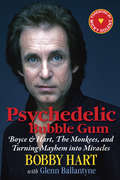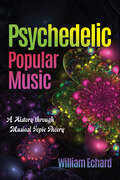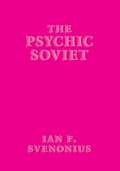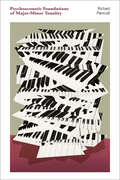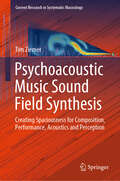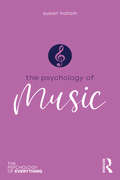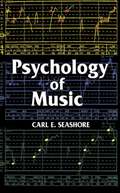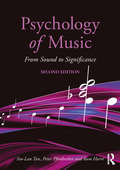- Table View
- List View
The Propaganda of Freedom: JFK, Shostakovich, Stravinsky, and the Cultural Cold War (Music in American Life)
by Joseph HorowitzThe perils of equating notions of freedom with artistic vitality Eloquently extolled by President John F. Kennedy, the idea that only artists in free societies can produce great art became a bedrock assumption of the Cold War. That this conviction defied centuries of historical evidence--to say nothing of achievements within the Soviet Union--failed to impact impregnable cultural Cold War doctrine. Joseph Horowitz writes: “That so many fine minds could have cheapened freedom by over-praising it, turning it into a reductionist propaganda mantra, is one measure of the intellectual cost of the Cold War.” He shows how the efforts of the CIA-funded Congress for Cultural Freedom were distorted by an anti-totalitarian “psychology of exile” traceable to its secretary general, the displaced Russian aristocrat/composer Nicolas Nabokov, and to Nabokov’s hero Igor Stravinsky. In counterpoint, Horowitz investigates personal, social, and political factors that actually shape the creative act. He here focuses on Stravinsky, who in Los Angeles experienced a “freedom not to matter,” and Dmitri Shostakovich, who was both victim and beneficiary of Soviet cultural policies. He also takes a fresh look at cultural exchange and explores paradoxical similarities and differences framing the popularization of classical music in the Soviet Union and the United States. In closing, he assesses the Kennedy administration’s arts advocacy initiatives and their pertinence to today’s fraught American national identity. Challenging long-entrenched myths, The Propaganda of Freedom newly explores the tangled relationship between the ideology of freedom and ideals of cultural achievement.
The Prophet Calls
by Melanie SumrowGentry Forrester feels lucky to live among God’s chosen people in the Prophet's compound, but when music is outlawed, Gentry and her older brother, Tanner, sneak out of the community. When they return, all bets are off as the Prophet exercises his control.Born into a polygamous community in the foothills of New Mexico, Gentry Forrester feels lucky to live among God’s chosen. Here, she lives apart from the outside world and its “evils.” On her thirteenth birthday, Gentry receives a new violin from her father and, more than anything, she wants to play at the Santa Fe Music Festival with her brother, Tanner. But then the Prophet calls from prison and announces he has outlawed music in their community and now forbids women to leave. Determined to play, Gentry and Tanner sneak out. But once they return, the Prophet exercises control from prison, and it has devastating consequences for Gentry and her family. Soon, everything Gentry has known is turned upside down. She begins to question the Prophet’s teachings and his revelations, especially when his latest orders put Gentry’s family in danger. Can Gentry find a way to protect herself and her family from the Prophet and escape the only life she’s ever known? This realistic, powerful story of family, bravery, and following your dreams is a can't-miss debut novel from Melanie Sumrow.
Prophet Singer: The Voice and Vision of Woody Guthrie (American Made Music Series)
by Mark Allan JacksonProphet Singer: The Voice and Vision of Woody Guthrie examines the cultural and political significance of lyrics by beloved songwriter and activist Woodrow Wilson “Woody” Guthrie. The text traces how Guthrie documented the history of America's poor and disadvantaged through lyrics about topics as diverse as the Dust Bowl and the poll tax. Divided into chapters covering specific historical topics such as race relations and lynchings, famous outlaws, the Great Depression, and unions, the book takes an in-depth look at how Guthrie manipulated his lyrics to explore pressing issues and to bring greater political and economic awareness to the common people. Incorporating the best of both historical and literary perspectives, Mark Allan Jackson references primary sources including interviews, recordings, drawings, and writings. He includes a variety of materials from the Smithsonian Institution, the Library of Congress, and the Woody Guthrie Archives. Many of these have never before been widely available. The result provides new insights into one of America's most intriguing icons. Prophet Singer offers an analysis of the creative impulse behind and ideals expressed in Guthrie's song lyrics. Details from the artist's personal life as well as his interactions with political and artistic movements from the first half of the twentieth century afford readers the opportunity to understand how Guthrie's deepest beliefs influenced and found voice in the lyrics that are now known and loved by millions.
Prophets of Love: The Unlikely Kinship of Leonard Cohen and the Apostle Paul (Advancing Studies in Religion #15)
by Matthew R. AndersonLeonard Cohen and the Apostle Paul might be imagined as brothers with wildly different characters but a strong family resemblance. Paul, the elder sibling, was awkward, abrasive, and zealous. Leonard, the successful younger brother, was a smooth-talking romantic, prone to addiction and depression. Paul died a martyr, not knowing his words would have any effect on the world. Leonard could see his canonization within his lifetime. Yet each became a prophet in his own time, and a poet for the ages.In Prophets of Love Matthew Anderson traces surprising connections between two Jewish thinkers separated by millennia. He explores Leonard's and Paul’s mysticism, their Judaism, their fascination with Jesus, their countercultural perspectives on sex, their ideas about love, and how they each embodied being men. Anderson considers their ambiguous relationships with women, on whom they depended and from whom they often profited, as well as how their legacies continue to evolve and be re-interpreted. This book emphasizes that Paul was first and foremost a Jew, and never rejected his Judaism. At the same time, it sheds new light on the biblical worldviews and language underlying and inspiring every line of Cohen’s poetry.Prophets of Love alters our views of both Leonard Cohen and the Apostle Paul, re-introducing us to two poetic prophets of divine and human love.
Prophets of the Hood: Politics and Poetics in Hip Hop
by Imani PerryAt once the most lucrative, popular, and culturally oppositional musical force in the United States, hip hop demands the kind of interpretation Imani Perry provides here: criticism engaged with this vibrant musical form on its own terms. A scholar and a fan, Perry considers the art, politics, and culture of hip hop through an analysis of song lyrics, the words of the prophets of the hood. Recognizing prevailing characterizations of hip hop as a transnational musical form, Perry advances a powerful argument that hip hop is first and foremost black American music. At the same time, she contends that many studies have shortchanged the aesthetic value of rap by attributing its form and content primarily to socioeconomic factors. Her innovative analysis revels in the artistry of hip hop, revealing it as an art of innovation, not deprivation. Perry offers detailed readings of the lyrics of many hip hop artists, including Ice Cube, Public Enemy, De La Soul, krs-One, OutKast, Sean "Puffy" Combs, Tupac Shakur, Lil' Kim, Biggie Smalls, Nas, Method Man, and Lauryn Hill. She focuses on the cultural foundations of the music and on the form and narrative features of the songs--the call and response, the reliance on the break, the use of metaphor, and the recurring figures of the trickster and the outlaw. Perry also provides complex considerations of hip hop's association with crime, violence, and misogyny. She shows that while its message may be disconcerting, rap often expresses brilliant insights about existence in a society mired in difficult racial and gender politics. Hip hop, she suggests, airs a much wider, more troubling range of black experience than was projected during the civil rights era. It provides a unique public space where the sacred and the profane impulses within African American culture unite.
Prosdocimo de' Beldomandi's Musica Plana and Musica Speculativa (Studies in the History of Music Theory and Literature)
by Prosdocimo de' BeldomandiAvailable in English for the first time, Prosdocimo's Tractatus plane musice (1412) and Tractatus musice speculative (1425) are exemplary texts for understanding the high sophistication of music theory in the early fifteenth century. Known for considering music as a science based on demonstrable mathematical principles, Prosdocimo praises Marchetto for his theory of plainchant but criticizes his influential Lucidarium for its heterodox mathematics. In dismissing Marchetto as a “mere performer,” Prosdocimo takes up matters as broad as the nature and definition of music and as precise as counterpoint, tuning, and ecclesiastical modes. The treatises also reveal much about Prosdocimo’s understanding of plainchant; his work with Euclid's Elementa; and his familiarity with the music theory of Boethius, Macrobius, and Johannes de Muris. A foremost authority on Italian music theory of the Middle Ages and early Renaissance, Jan Herlinger consults manuscripts from Bologna, Cremona, and Lucca in preparing these valuable first critical editions.
Protest Music in France: Production, Identity and Audiences (Ashgate Popular and Folk Music Series)
by Barbara LebrunBarbara Lebrun traces the evolution of 'protest' music in France since 1981, exploring the contradictions that emerge when artists who take their musical production and political commitment 'seriously', cross over to the mainstream, becoming profitable and consensual. Contestation is understood as a discourse shaped by the assumptions and practices of artists, producers, the media and audiences, for whom it makes sense to reject politically reactionary ideas and the dominant taste for commercial pop. Placing music in its economic, historical and ideological context, however, reveals the fragility and instability of these oppositions. The book firstly concentrates on music production in France, the relationships between independent labels, major companies and the state's cultural policies. This section provides the material background for understanding the development of rock alternatif, France's self-styled 'subversive' genre of the 1980s, and explains the specificity of a 'protest' music culture in late-twentieth-century France, in relation to the genre's tradition in the West. The second part looks at representations of a 'protest' identity in relation to discourses of national identity, focusing on two 1990s sub-genres. The first, chanson néo-réaliste, contests modernity through the use of acoustic instruments, but its nostalgic 'protest' raises questions about the artists' real engagement with the present. The second, rock métis, borrows from North African and Latino rhythms and challenges the 'neutral' Frenchness of the Republic, while advocating multiculturalism in problematic ways. A discussion of Manu Chao's career, a French artist who has achieved success abroad, also allows an exploration of the relationship between transnationalism and anti-globalization politics. Finally, the book examines the audiences of French 'protest' music and considers festivals as places of 'non-mainstream' identity negotiation. Based on first-hand interviews, this section highlights the vocabulary of emotions that audiences use to make sense of an 'alternative' performance, unveiling the contradictions that underpin their self-definition as participants in a 'protest' culture. The book contributes to debates on the cultural production of 'resistance' and the representation of post-colonial identities, uncovering the social constructedness of the discourse of 'protest' in France. It pays attention to its nation-specific character while offering a wider reflection on the fluidity of 'subversive' identities, with potential applications across a range of Western music practices.
The Protest Singer: An Intimate Portrait of Pete Seeger
by Alec WilkinsonA spirited and intimate look at American icon and activist Pete Seeger. Throughout his life, Pete Seeger transformed a classic American musical style into a form of peaceful protest against war, segregation, and nuclear weapons. Drawing on his extensive talks with Seeger, Alec Wilkinson delivers a first hand look at Seeger's unique blend of independence and commitment, charm, courage, energy, and belief in human equality and American democracy. We see Seeger as a child, instilled with a love of music by his parents; as a teenager, hearing real folk music for the first time; as a young adult, singing with Woody Guthrie. And finally, Seeger the man marching with the Rev. Martin Luther King in Selma, standing up to McCarthyism, and fighting for his beloved Hudson River. The gigantic life captured in this slender volume is truly an American anthem.
Protestpop und Krautrock (Kontemporär. Schriften zur deutschsprachigen Gegenwartsliteratur #18)
by Markus Joch Christoph Jürgensen Gerhard KaiserDie knapp eineinhalb Jahrzehnte nach 1970 erscheinen im Rückblick als eine Art Sattelzeit der deutschen Popmusik: Fast alle maßgeblichen, zukunftsträchtigen Stile, Artikulations- und Inszenierungsweisen des deutschen Pop entwickeln und etablieren sich in diesem Zeitraum. Das sich in zunehmendem Maße ausdifferenzierende Spektrum reicht vom Protestpop über den sogenannten Krautrock bis hin zu einer auf Breitenwirksamkeit setzenden Rockmusik sowie den später unter dem ebenso unpräzisen wie wirkmächtigen label „Neue Deutsche Welle“ rubrizierten Spielweisen. Der Band wirft zum einen einen neuen Blick auf Geschichte und Spielarten des äußerst heterogenen Protestpop vom Anarcho-Rock der Ton Steine Scherben bis zu BAP, den Lindenberg in punkto Massenresonanz überholenden Kölschrockern. Zum anderen analysiert der Band die musikalischen, textlichen und performativen Inszenierungsstrategien des Krautrock der frühen 1970er Jahre. Der vor allem von der englischsprachigen Popbeobachtung zunächst pejorativ verwendete Begriff des Krautrock ist freilich diffus, da er ein Spektrum ganz unterschiedlicher Stile umfasst. Dieses reicht vom Rock bis zu den elektronischen Klangexperimenten von so unterschiedlichen Bands wie Tangerine Dream, Cluster oder Kraftwerk. Einigendes Band dieser unterschiedlichen Akteure scheint jedoch die dezidierte Abgrenzung von angloamerikanischen Vorbildern zu sein.
Proust's Songbook: Songs and Their Uses (Sound in History)
by Jennifer RushworthIn Proust’s Songbook, Jennifer Rushworth analyzes and theorizes the presence and role of songs in Marcel Proust’s novel À la recherche du temps perdu (In Search of Lost Time). Instead of focusing on instrumental music and large-scale forms such as symphonies and opera, as is common in Proust musical studies, Rushworth argues for the centrality of songs and lyrics in Proust’s opus. Her work analyzes the ways in which the author inserted songs at key turning points in his novel and how he drew inspiration from contemporary composers and theorists of song. Rushworth presents detailed readings of five moments of song in À la recherche du temps perdu, highlighting the songs’ significance by paying close attention to their lyrics, music, composers, and histories.Rushworth interprets these episodes through theoretical reflections on song and voice, drawing particularly from the works of Reynaldo Hahn and Roland Barthes. She argues that songs in Proust’s novel are connected and resonate with one another across the different volumes yet also shows how song for Proust is a solo, amateur, and intimate affair. In addition, she points to Proust’s juxtapositions of songs with meditations on the notion of “mauvaise musique” (bad music) to demonstrate the existence of a blurred boundary between songs that are popular and songs that are art.According to Rushworth, a song for Proust has a special relation to repetition and memory due to its typical brevity and that song itself becomes a mode of resistance in À la Recherche—especially on the part of characters in the face of family and familial expectations. She also defines the songs in Proust’s novel as songs of farewell—noting that to sing farewell is a means to resist the very parting that is being expressed—and demonstrates how songs, in formal terms, resist the forward impetus of narrative.
A Provincial Organ Builder in Victorian England: William Sweetland of Bath (Music in Nineteenth-Century Britain)
by Gordon D.W. CurtisWilliam Sweetland was a Bath organ builder who flourished from c.1847 to 1902 during which time he built about 300 organs, mostly for churches and chapels in Somerset, Gloucestershire and Wiltshire, but also for locations scattered south of a line from the Wirral to the Wash. Gordon Curtis places this work of a provincial organ builder in the wider context of English musical life in the latter half of the nineteenth century. An introductory chapter reviews the provincial musical scene and sets the organ in the context of religious worship, public concerts and domestic music-making. The book relates the biographical details of Sweetland's family and business history using material obtained from public and family records. Curtis surveys Sweetland's organ- building work in general and some of his most important organs in detail, with patents and other inventions explored. The musical repertoire of the provinces, particularly with regard to organ recitals, is discussed, as well as noting Sweetland's acquaintances, other organ builders, architects and artists. Part II of the book consists of a Gazetteer of all known organs by Sweetland organized by counties. Each entry contains a short history of the instrument and its present condition. Since there is no definitive published list of his work, and as all the office records were lost in a fire many years ago, this will be the nearest approach to a comprehensive list for this builder.
Psalm 23
by Barry MoserThis popular psalm, taken from the NIV, is paired with lush illustrations by Barry Moser, resulting in a picture book that makes the pastures come alive.
Psalms 1-72: An Introduction and Commentary (Tyndale Old Testament Commentaries Series #Volume 15)
by Derek KidnerDerek Kidner provides a fresh and penetrating guide to Psalms 1-72. He analyzes each psalm in depth, comments on interpretive questions and lays bare the universal relevance of the texts. In addition he gives special help on the psalmists' cries for vengeance. Together with its companion volume (Psalms 73-150) this introduction and commentary will inspire and deepen personal worship.
PSICODELIA SUBURBANA - David Bowie e o Beckenham Arts Lab
by Alessandra Lobo Mary FinniganEste livro não é sobre as músicas do David Bowie. Existem vários livros já escritos sobre isso. É um livro sobre uma fatia única da história, sobre quando os jovens ao Sul de Londres se uniram para uma experiência mágica cujo auge se deu na tarde de 16 de agosto. Posso escrever uma prosa razoável, mas não sou nenhuma poeta genial ou musicista. David Bowie era desde calibre. As palavras em sua canção "Memory of a Free Festival" e a melodia que segue com ela reflete bem melhor toda a atmosfera daquele dia do que qualquer tentativa que eu faça.
Psychedelic Bubble Gum: Boyce & Hart, The Monkees, and Turning Mayhem into Miracles
by Micky Dolenz Glenn Ballantyne Bobby HartFrom the man who wrote the music that outsold the Beatles and the Rolling Stones in 1967-1968, . Immerse yourself in Grammy, Golden Globe, and Academy Award nominated songwriter Bobby Hart's world as he shares an exclusive glimpse into his life. Psychedelic Bubble Gum is the story behind his success, the rise of Boyce and Hart as musical goliaths, and their role in launching the Monkees to stardom. With unbending sincerity, Hart details a life of extravagance, betrayal, loss, disillusionment, and an unstoppable personal struggle to find balance, peace, and love. Psychedelic Bubble Gum is a rollercoaster ride through the 1960s and 70s America's whirlwind era of free speech, mysticism, and psychedelic pop culture packed with intimate behind-the-scenes encounters with pop star royalty. Psychedelic Bubble Gum is tempered by humor, honesty, and a singular understanding of the industry.
Psychedelic Popular Music: A History through Musical Topic Theory (Musical Meaning and Interpretation)
by William EchardRecognized for its distinctive musical features and its connection to periods of social innovation and ferment, the genre of psychedelia has exerted long-term influence in many areas of cultural production, including music, visual art, graphic design, film, and literature. William Echard explores the historical development of psychedelic music and its various stylistic incarnations as a genre unique for its fusion of rock, soul, funk, folk, and electronic music. Through the theory of musical topics—highly conventional musical figures that signify broad cultural concepts—and musical meaning, Echard traces the stylistic evolution of psychedelia from its inception in the early 1960s, with the Beatles' Rubber Soul and Revolver and the Kinks and Pink Floyd, to the German experimental bands and psychedelic funk of the 1970s, with a special emphasis on Parliament/Funkadelic. He concludes with a look at the 1980s and early 1990s, touching on the free festival scene, rave culture, and neo–jam bands. Set against the cultural backdrop of these decades, Echard's study of psychedelia lays the groundwork and offers lessons for analyzing the topic of popular music in the twentieth and twenty-first centuries.
The Psychic Soviet
by Ian F. SvenoniusA reissue of Ian F. Svenonius's cult-classic debut essay collection, including brand-new writing in this expanded edition. "Everything author-slash-punk-icon Ian Svenonius says is interesting, and this book of satirical essays--originally publ
Psychoacoustic Foundations of Major-Minor Tonality
by Richard ParncuttA fascinating interdisciplinary approach to how everyday Western music works, and why the tones, melodies, and chords combine as they do.Despite the cultural diversity of our globalized world, most Western music is still structured around major and minor scales and chords. Countless thinkers and scientists of the past have struggled to explain the nature and origin of musical structures. In Psychoacoustic Foundations of Major-Minor Tonality, music psychologist Richard Parncutt offers a fresh take, combining music theory—Rameau&’s fundamental bass, Riemann&’s harmonic function, Schenker&’s hierarchic analysis, Forte&’s pitch-class set theory—with psychology—Bregman&’s auditory scene, Terhardt&’s virtual pitch, Krumhansl&’s tonal hierarchy. Drawing on statistical analyses of notated music corpora, Parncutt charts a middle path between cultural relativism and scientific positivism to bring music theory into meaningful discourse with empirical research.Our musical subjectivity, Parncutt explains, depends on our past musical experience and hence on music history and its social contexts. It also depends on physical sound properties, as investigated in psychoacoustics with auditory experiments and mathematical models. Parncutt&’s evidence-based theory of major-minor tonality draws on his interdisciplinary background to present a theory that is comprehensive, creative, and critical. Examining concepts of interval, consonance, chord root, leading tone, harmonic progression, and modulation, he asks:Why are some scale tones and chord progressions more common than others?What aspects of major-minor tonality are based on human biology or general perceptual principles? What aspects are culturally arbitrary? And what about colonial history?Original and provocative, Psychoacoustic Foundations of Major-Minor Tonality promises to become a foundational text in both music theory and music cognition.
Psychoacoustic Music Sound Field Synthesis: Creating Spaciousness for Composition, Performance, Acoustics and Perception (Current Research in Systematic Musicology #7)
by Tim ZiemerThis book provides a broad overview of spaciousness in music theory, from mixing and performance practice, to room acoustics, psychoacoustics and audio engineering, and presents the derivation, implementation and experimental validation of a novel type of spatial audio system. Discussing the physics of musical instruments and the nature of auditory perception, the book enables readers to precisely localize synthesized musical instruments while experiencing their timbral variance and spatial breadth.Offering interdisciplinary insights for novice music enthusiasts and experts in the field of spatial audio, this book is suitable for anyone interested in the study of music and musicology and the application of spatial audio mixing, or those seeking an overview of the state of the art in applied psychoacoustics for spatial audio.
Psychoakustische Schallfeldsynthese für Musik: Raum schaffen für Komposition, Aufführung, Akustik und Wahrnehmung
by Tim ZiemerDieses Buch bietet einen umfassenden Überblick über die Räumlichkeit in der Musiktheorie, von der Abmischung und Aufführungspraxis bis hin zur Raumakustik, Psychoakustik und Tontechnik, und stellt die Ableitung, Implementierung und experimentelle Validierung eines neuartigen räumlichen Audiosystems vor. Durch die Erörterung der Physik von Musikinstrumenten und der Natur der auditiven Wahrnehmung ermöglicht das Buch den Lesern, synthetische Musikinstrumente präzise zu lokalisieren und gleichzeitig ihre klangliche Varianz und räumliche Weite zu erleben. Dieses Buch bietet interdisziplinäre Einblicke für Musikneulinge und Experten auf dem Gebiet der räumlichen Audiotechnik. Es eignet sich für alle, die sich für das Studium von Musik und Musikwissenschaft und die Anwendung von räumlichen Audiomischungen interessieren oder einen Überblick über den Stand der Technik in der angewandten Psychoakustik für räumliches Audio suchen.
Psychobilly: Subcultural Survival
by Kimberly Kattari“I got 1-2-3-4 psychobilly DNA”—Norm and the Nightmarez Call it punk rockabilly with science-fiction horror lyrics. The outsider musical genre known as psychobilly, which began in 1980s Britain, fuses punk, heavy metal, new wave, and shock rock with carnivalesque elements. The participants in this underground scene sport coffin tattoos and 1950s fashions. Bands such as The Meteors, Nekromantix, and Demented Are Go play with a wild energy and a fast tempo. Sometimes fake blood runs down a performer’s mouth. Psychobilly is ethnomusicologist Kimberly Kattari’s fascinating, decade-long study of this little-known anti-mainstream genre. She provides a history and introduces readers to the core aspects of the music as she interviews passionate performers and fans. Kattari seeks to understand how psychobilly so strongly affects—and reflects—its participants’ lives and identities so strongly. She observes that it provides not only a sense of belonging but a response to feelings and experiences of socio-economic marginalization and stigmatization. Psychobilly shows how this subculture organized around music furnishes an outlet for members to resist normative expectations and survive; they adhere to their own rules by having a good time while going through a hard time.
Psychological Health Effects of Musical Experiences
by Töres TheorellThis book is about links between music and health. It focuses on music and public health, and, in particular, the potentially positive and negative effects of listening to and making music on the health of the general population. The book starts out by discussing the protection music offers against adverse effects of stress. It then discusses social aspects of music production and listening and examines religious music within the framework of social functioning. It offers insight into the physiological and psychological effects of music listening, the biological effects of singing, and the use of music in therapeutic situations and the rearing of children. The book concludes by discussing the significance of music for musicians and their health. Although it may seem that music has only good health effects, and therefore all professional musicians should be healthy, not all music effects are positive. The book describes situations in which music has negative health effects and makes clear that there is a pronounced difference between living with music for joy and to earn one´s living from making music. In the latter situation, performance anxiety may become a factor that affects health adversely.
Psychology of Music (The Psychology of Everything)
by Susan HallamHow does music affect our moods? What is the best way to develop musical skills? How does the definition of music vary between cultures? The Psychology of Music explores the important impact music has on our everyday lives, and its influence on society, groups and individual people. It demonstrates how music can benefit our intellectual functioning, and health and well-being, and examines musical ability as both a gift and something that can be developed through learning and practice. Music can enhance our understanding of humanity and modern life and The Psychology of Music shows us the significance of music, and the power it can have over our behaviour.
Psychology of Music
by Carl E. SeashoreBetween the physical world of vibration, as measured by apparatus, and the world of consciously heard music there is a third area of investigation. Our auditory apparatus and/or mind separates different instruments and tones, hears some vibrations but not others, adds tones to fill out the sound spectrum, etc. This middle ground is the province of the psychology of music, a subject about which even many physical scientists know little.This introduction, by the developer of the Seashore test of musical ability, is a thorough survey of this field, the standard book for psychologists specializing in the area, for the school, and for interested musicologists. It opens with the musical mind and with a series of chapters on music as a medium: vibrato, pitch, loudness, duration, timbre, tone, consonance, volume, and rhythm, dealing with each from the special point of view of the role of psychology. It then moves to such factors as learning, imagining, and thinking in music; the nature of musical feeling; the relative sound patterns of specific instruments and the human voice; measures of musical talent; inheritance of musical ability; primitive music; the development of musical skills; and musical aesthetics.This wealth of material is supplemented with dozens of oscillograms and other sound-pattern charts recorded from actual play and singing by Jeritza, Caruso, Paderewski, Szigeti, Rethberg, Menuhin, Martinelli, and other artists. An appendix cites two attitudes toward the evaluation of musical talent and over 200 bibliographic references.
Psychology of Music: From Sound to Significance
by Siu-Lan Tan Peter Pfordresher Rom HarréIn Psychology of Music: From Sound to Significance (2nd edition), the authors consider music on a broad scale, from its beginning as an acoustical signal to its different manifestations across cultures. In their second edition, the authors apply the same richness of depth and scope that was a hallmark of the first edition of this text. In addition, having laid out the topography of the field in the original book, the second edition puts greater emphasis on linking academic learning to real-world contexts, and on including compelling topics that appeal to students’ natural curiosity. Chapters have been updated with approximately 500 new citations to reflect advances in the field. The organization of the book remains the same as the first edition, while chapters have been updated and often expanded with new topics. 'Part I: Foundations' explores the acoustics of sound, the auditory system, and responses to music in the brain. 'Part II: The Perception and Cognition of Music' focuses on how we process pitch, melody, meter, rhythm, and musical structure. 'Part III: Development, Learning, and Performance' describes how musical capacities and skills unfold, beginning before birth and extending to the advanced and expert musician. And finally, 'Part IV: The Meaning and Significance of Music' explores social, emotional, philosophical and cultural dimensions of music and meaning. This book will be invaluable to undergraduates and postgraduate students in psychology and music, and will appeal to anyone who is interested in the vital and expanding field of psychology of music.
